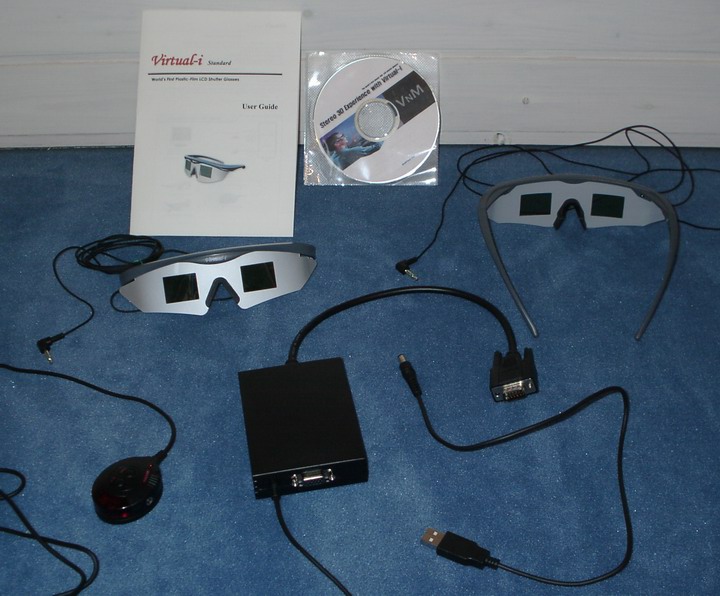

VNM Virtual-i review
by Christoph Bungertpage initialy released on Feb. 19, 2003
last update on Feb. 27, 2003
contentin a nutshell
Pro & Con
the glasses
Never trust a first impression
comfort
LCD-panels
cable
durability and workmanship
glasses comparison
the controller
tested resolutions
signal quality
the emitter
wireless glasses support
3-way-power
why the Virtual-i controller is so cool
This review isn't intended for beginners,
since many terms like line-blanking or sync-doubling
aren't explained here.Please check
the gaming basics,
the FAQ,
the basics,
the formats,
the indexYou can also post questions to the webboard.
in a nutshellThe Virtual-i package distributed by VNM, Inc. is a 3D-shutterglasses system for real stereoscopic 3D visuals on a standard CRT (tube) monitor.
The system consists of a universal 4-in-1 VGA-pass-through controller, 1 or 2 pairs of glasses, USB-power-cable, printed 4 page manual, driver- and demo-CD-ROM
The wired glasses (model SP-VI-A-100) are manufactured by SoftPixel, Inc.
The controller (model K3K010) is manufactured by Witvision Co. Ltd. (formerly known as Woobo)
thin-film LCD's
The Virtual-i uses liquid crystal shutters on a plastic-film-carrier, rather than a glass-carrier. These plastic-LCD's are lighter, won't break and can form round shapes.
availability
The Virtual-i cannot be bought by end-consumers at this point. The manufacturer is preparing mass-production and is seeking for OEM-partners. You can actually place volume orders now. For the consumer the glasses should become available in the forseable future under various different brand names. Wireless glasses and a Video/DVD-Controller are in final stages of development. I won't mention the volume OEM-prices here, but they seem to be good value for money - when ordering 10,000+ units.
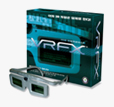
The VRFX package by Witvision Co. Ltd. which consists of the same controller, but different shutterglasses (glass-LCD based) is available in Korea since Feb. 10, 2003. The VRFX should be available soon in the USA too. Witvision may adopt the plastic-LCD glasses by Softpixel for future packages.
conclusion
The Virtual-i comes with the best controller on the market, even better than the Eye3D-Premium. Virtual-i is compatible to any stereo-software imaginable. The wired shutterglasses are the lightest on the market and provide the best comfort available. The optic quality is O.K. The LCD-panels are rather small, but sufficient for most users (VNM also offers larger versions). The Virtual-i is a low-cost consumer product, but in this regard it's a marvelous system. In terms of comfort and compatibility it's second to none.
Pro Con
wireless glasses:- not reviewed yet
+ IR-emitter supports at least these 3rd party wireless glasses: i-Art, Kasan and 3DTVwired glasses (model SP-VI-A-100):
+ ultra-light
+ only 27g (35g with cable and connector)
+ extremely comfortable
+ soft rubber nose piece
+ fits over prescribed glasses
+ ultra-light, ultra thin 'thin-film-LCD-panels' with worthwile optical quality
+185 cm cablecontroller (model K3K010):
+ most flexible and compatible controller imaginable
+ compatible to everything now and forever
+ good sync-accuracy *)
+ full manual control
+ automatic control (Revelator-trigger)
+ behaves exactly like Revelator if set to power-off
+ compatible to any current or future stereo-driver, stereo-software or stereo-content including nVidia, WINx3D, Wicked3D, Revelator, VRCaddy, 3dplus and ASUS drivers
+ autosync to page-flipping and interlace
+ sync-doubler
+ line-blanker
+ reverse button (works even in Revelator-mode)
+ supports wired and wireless glasses
+ IR-emitter supports at least VNM, i-Art, Kasan and 3DTV IR-glasses
+ 2 standard 3.5 mm stereo connectors for wired glasses
+ 3-way-power supply: draws power from VGA, USB or standard power adaptor
+ supports insanely high resolutions and refresh rates
+ mechanically stable installation
+ IR-emitter separated from dongle with 190 cm cablesoftware:
+ sample came with 1 CD: nVidia reference Detonator and stereo driver, Harry Potter 2 game demo, 3D landscape photos in interlace format with music, 2 high quality over-under format video clips
+ sample came with printed 4-page manual
wireless glasses: - not reviewed yet
wired glasses (model SP-VI-A-100):
- LCD-panels of sample rather small (manufacturer also offers larger versions)
- plastic-LCD's not as clear and flawless than hi-quality glass-LCD's (doesn't make much difference during use)
- very thin cable
- just average durability and workmanship (this is a low-cost, mass-production, consumer product)controller (model K3K010):
- no mode-indicator LED (not a real problem)
- no VESA DIN-3 connectors (not a real problem)
- doesn't support color-control-codes (not a real problem)
- doesn't support IR-code of wireless Revelator/H3D/i-glasses (not a real problem)
*) Inaccuracies in synchronization may appear as darker stripes on top or bottom of the screen, uneven distribution of brightness over the screen or perceivable flicker even at high refresh. The effect varies with graphics mode, refresh, vga-board, monitor, cabling and may even spread within the same controller model line.
the glasses
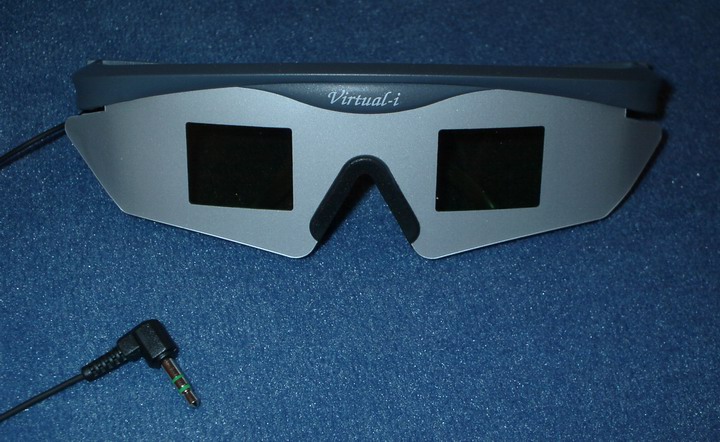
the wired glasses (model SP-VI-A-100) have a standard 3.5 mm stereo jack
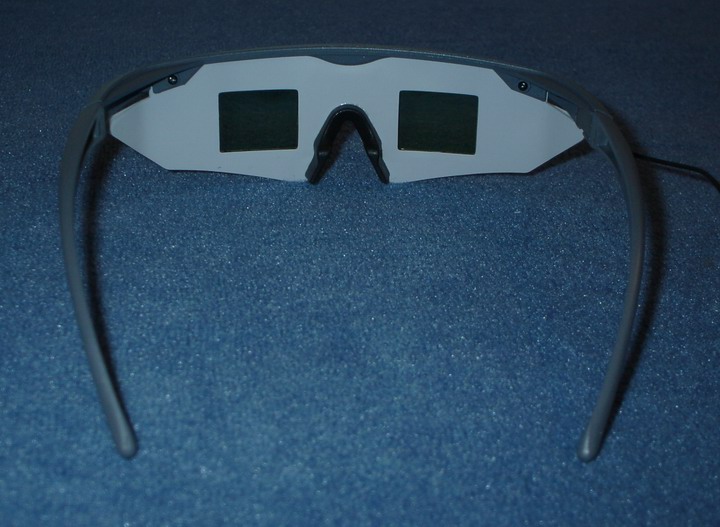
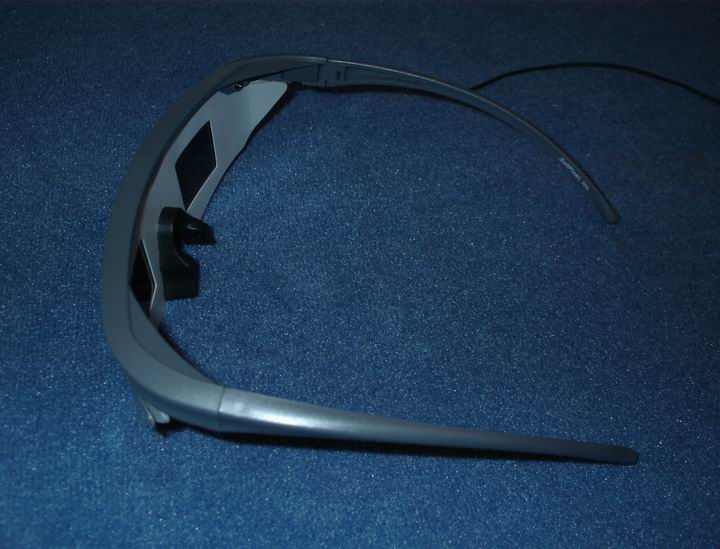
When I took the glasses out of the box my first impression was: uhh these are cheap, low-end glasses. They doesn't seem very durable, the cable is thin and stubborn, there are production glitches, like a misaligned LCD-panel, the LCD-panels are way too small and these plastic-LCD's shurely won't have the same optical quality as glass-LCD's.
Well that's what I thought! What happened is that after two hours of stereo-gaming I realized that I'm addicted to these glasses and will hardly ever use any other glasses again from now on. The LCD-panels are relatively small, but I could see the whole 21" monitor. The image was undistorted and I couldn't find notable differences in image appearance compared to glass-LCD's, like those from i-O-Display, i-Art, ASUS, etc.
comfortThese glasses weight in at about 27 grams. They are incredibly light and comfortable, just like plastic sun-glasses. It changed the way I use shutterglasses. I keep them on much longer. The glasses have a soft rubber nose-piece, fit perfectly over prescribed glasses and don't tend to slip.
I must admit the wired versions of the Revelator and the iO-Display (i-glasses, eDimensional, X3D) glasses weight about 30 to 35 grams, so they are very close. They have glass-LCD's and their temples are adjustable, but these glasses have smaller frames and a smaller, harder nose-piece.
In the end there are no perfect glasses for everyone, it depends on head-size and eye-distance. If your head is large you may be better off with the Virtual-i.
LCD-panelsOn close inspection the thin-film plastic-LCD's doesn't seem as clear and flawless as glass-LCD's. They are also somewhat harder to clean. Nevertheless, during use I couldn't see a noticeable difference in optical quality and ghosting compared to glass-LCD's.
The panels of the Virtual-i are only slightly smaller than the current Revelator/i-glasses/eDimensional glasses. They appear smaller as they are, due to the large frame. Although I wear prescribed glasses under the shutterglasses I had no problems even on a 21" monitor. If someone has a significantly smaller or wider eye-distance there could be a problem with the Virtual-i's though.
The Virtual-i isn't in mass-production yet. The manufacturer offers larger panel-versions and is waiting for orders from future OEM-partners. So before you place an order for 20,000 units or so you may think about getting a larger version.
cableWith 185 cm the cable is more than long enough, especially if you take into account that they are conncted to the emitter unit which has already a long cable of it's own. The cable is very thin and light. Usually that's an advantage, but thin cables tend to be more messy than thicker, smoother cables. The durability of the cable in the long term has to be seen.
These glasses are designed as a low-cost consumer product, so don't expect something professional. On one of the samples a LCD-panel was slightly misaligned, but this didn't influence function. According to the manufacturer this is a pre-production glitch and won't happen in mass-production. The Virtual-i wired are a very light, plastic contruction, but if one treats them right they should hold for a long time.
If you can't stay the glasses for one reason or another you may consider buying some other wired glasses on eBay and plug them into the really excellent Virtual-i controller. You can even use certain 3rd party wireless glasses.
glasses comparison weight panels w x h Virtual-i wired 27 grams 2.8 x 2.2 cm i-glasses-wired 35 grams 3.0 x 2.3 cm Revelator/i-glasses wireless 45 grams 3.0 x 2.5 cm Asus wired 70 grams 4.3 x 2.5 cm StereoGraphics CrystalEyes 2 90 grams (<6) x 3.5 cm
the controller
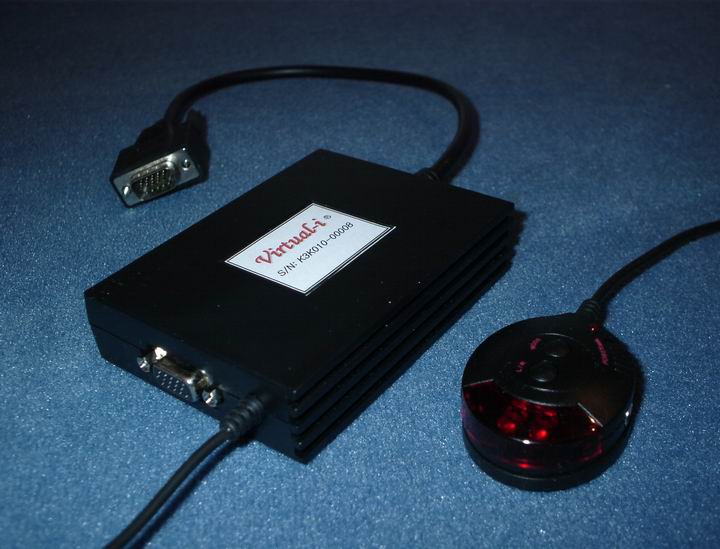
Virtual-i 4-in-1 Controller (model K3K010)
The VGA-pass-through controller syncs to any page-flipping or interlace signal and also provides line-blanking and sync-doubling. The cable between the controller and the emitter is 190cm long
tested resolutions (on 130 kHz monitor):
Line blanking: 640x480@200Hz, 800x600@170Hz, 1024x768@150Hz, 1280x1024@120Hz, 2048x1536@75
Sync-doubling: 1280x1024@75/150Hz, 1600x1200@75/150Hz, 2048x1536@75/150HzThe controller accepts everything you throw at it.
signal qualityEvery VGA-pass-through controller can weaken the VGA-signal to some degree. The Virtual-i controller may be no exception, but the manufacturer claims that there's a signal-booster in there to accomodate for this effect. On my old 17" I had the impression that there was a certain loss in sharpness under high-resolutions with the virtual-i controller installed. On my new 21" I couldn't see a degradation, even under insanely high resolutions and refreshs. Everything goes into the equation: VGA-board, cable, monitor. If these components have enough 'reserves' you may not notice any differences.
The emitter unit of the controller has an IR-emitter which supports at least VNM, Kasan, i-Art and 3DTV wireless glasses, 2 x 3.5 mm connectors for wired glasses (one on each side), Power LED, power switch, mode button, reverse button
In power-off position the controller behaves like Revelator. In power-on position one has full manual control of all features.
wireless glasses supportSince the wireless version of the virtual-i's isn't available yet I tried some 3rd party wireless glasses from i-Art, Kasan and 3DTV. The sync-accuracy is pretty good. My impression was that with the Eye3D-Premium wireless glasses the sync was better than with the original 'Premium' controller.
The IR-code of the wireless Revelator/H3D/i-glasses/eDimensional glasses is NOT supported.
wireless IR-glasses supported by Virtual-i controller 3DTV Yes Another I's No i-Art Yes iO-Display(H3D, Revelator, i-glasses, eDim.) No Kasan 3D-Max Yes NuView 60GX No
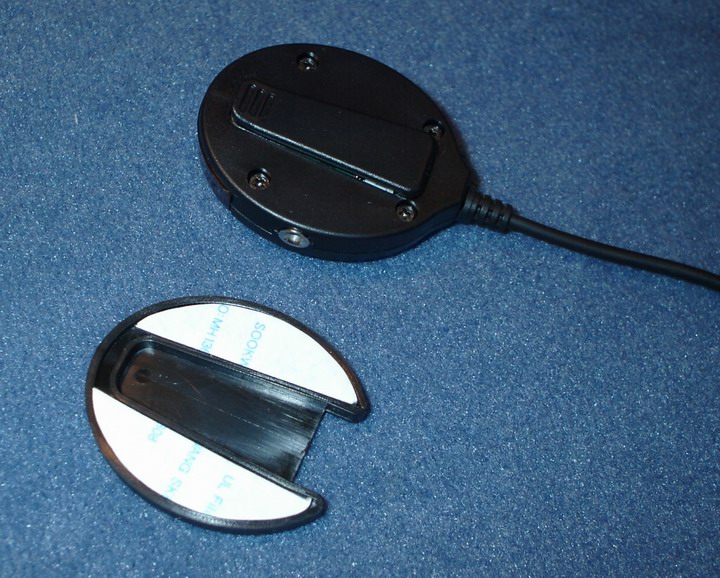
emitter clip
The emitter has a clip on the back to attach to your shirt or to the base which can be glued to the monitor.
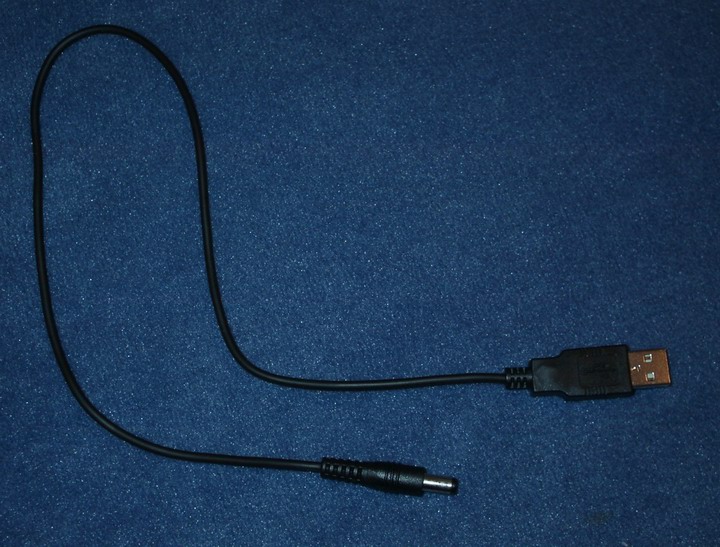
3-way-power
1) As long as the VGA-out of the VGA-port delivers power - and most new VGA-boards do - no additional supply is required
2) If there's no power from the VGA-board one can use the USB-power adaptor cable
3) If there's no free USB port one can use a standard power adaptor (not included, please ask manufacturer for specification)
why the Virtual-i controller is so coolUp to now my favorite shutterglasses controller was the i-Art Eye3D Premium controller. For the first time there was a controller which supported all imaginable shutter-stereo-modes (page-flipping, interlace, sync-doubling and line-blanking) and combined it with full manual control by hardware buttons. The result was perfect compatibility with all imaginable stereo-drivers and any stereo-content. In addition it supported both wired and wireless glasses.
The Virtual-i controller has all that, plus more. The Premium had a the much too long, mechanically unstable VGA-dongle. The Virtual-i controller is a much more elegant design. The 3-way power supply is another plus.
What really sets the Virtual-i apart is the Revelator-trigger-compatibility when set to power-off. As a result you don't have to set modes manually when using the nVidia reference stereo driver. The glasses turn on and off by themselves and usually the right stereo-orientation is selected. The reverse button remains operational in Revelator-mode though. This comes in very handy if you connect 3rd party glasses to the controller which are reverse-wired or if you watch stereo-photos which may be reversed.
The Virtual-i controller has no real disadvantages compared to the 'Premium' or any other competitors, but it should be mentioned that there is no mode-indicator-LED and it doesn't listen to any color-line-codes. Some applications and drivers (like the outdated Wicked3D) provide a color code so one doesn't have to reach for the buttons. There are controllers like those by i/O-Display (i-glasses, eDimensional, X3D, etc.) which are only controlled by Revelator trigger or color codes. There are no buttons. If you don't have a software which delivers these codes (e.g. under MacOS or Linux) you're lost.
The Virtual-i controller is my all-time favorite so far and it will most likely come at a lower price than the 'Premium'.
Sample provided by
VNM Inc.
Brand and product names are trademarks or registered trademarks of their respective holders.
The author doesn't guarantee the accuracy of the information given on this page.
The text and images on this page are the intellectual property of the author.
Don't copy any part of it without credit and link to this site!